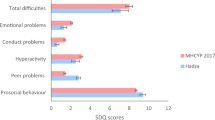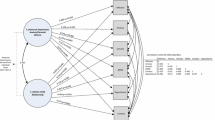Abstract
Parents, mostly mothers, of French and Dutch children who had been referred to Mental Health Services, completed the CBCL to indicate the behaviour problems that their children suffered from. The 85 items which had been found in the USA to measure eight types of disturbed behaviour, called the cross-informant syndromes, were studied to see if a similar set of dimensions of disturbed behaviour would underlie the Dutch and French CBCL scores. Seven types of disturbance were found which corresponded to the equivalent cross informant syndromes, but thought problems had no similar sort of disorder amongst the Dutch and French children. It was found that only 43 items were necessary to measure these seven dimensions. It was concluded that despite differences in language, culture and the pattern of mental health services, the CBCL scores could be used to make meaningful clinical comparisons of psychiatric disturbances.
Similar content being viewed by others
References
Achenbach TM (1991) Integrative Guide for the 1991 CBCL/4-18, YSR and TRF Profiles. University of Vermont, Burlington VT
Achenbach TM, Edelbrock C (1986) Manual for the Teacher's Report Form and Teacher Version of the Child Behavior Profile. University of Vermont, Department of Psychiatry, Burlington VT
Achenbach TM and Edelbrock C (1987) Manual for the Youth Self-Report and Profile. University of Vermont, Department of Psychiatry, Burlington VT
Ahmavaara Y (1957) On the unified factor theory of mind. Annale Akademie Scientiarum Fennicae (Series B) 106:51–76
Berg I, Lucas C, McGuire R (1992) Measurement of behaviour difficulties in children using standard scales administered to mothers by computer: reliability and validity. European Child and Adolescent Psychiatry 1:14–23
Cronbach L (1960) Essentials of Psychological Testing (2nd Edition). Harper and Row, New York
Deary U, Hepburn DA, MacLeod KM, Frier BM (1993) Partitioning the symptoms of hypoglycaemia using multi-sample confirmatory factor analysis. Diabetologia 36:771–777
DeGroot A, Koot H, Verhulst F (1995) The crosscultural generalizability of the CBCL cross-informant syndromes. Psychological Assessment 6:225–230
Dunn G, Everitt B, Pickles A (1993) Modelling Covariances and Latent Variables Using EQS. Chapman and Hall, London
Fombonne E (1989) The Child Behavior Checklist and the Rutter Parental Questionnaire: a comparison between two screening instruments. Psychological Medicine 19:777–785
Hatcher L (1994) A Step by Step Approach to using the SAS System for Factor Analysis and Structural Equation Modelling. SAS Institute, Cary, NC
Verhulst F, Achenbach T (1995) Empirically based assessment and taxonomy of psychopathology: cross cultural applica tions. A review. European Child & Adolescent Psychiatry 4:61–76
Author information
Authors and Affiliations
Rights and permissions
About this article
Cite this article
Berg, I., Fombonne, E., McGuire, R. et al. A cross cultural comparison of French and Dutch disturbed children using the Child Behaviour Checklist (CBCL). European Child & Adolescent Psychiatry 6, 7–11 (1997). https://doi.org/10.1007/BF00573634
Received:
Accepted:
Issue Date:
DOI: https://doi.org/10.1007/BF00573634




